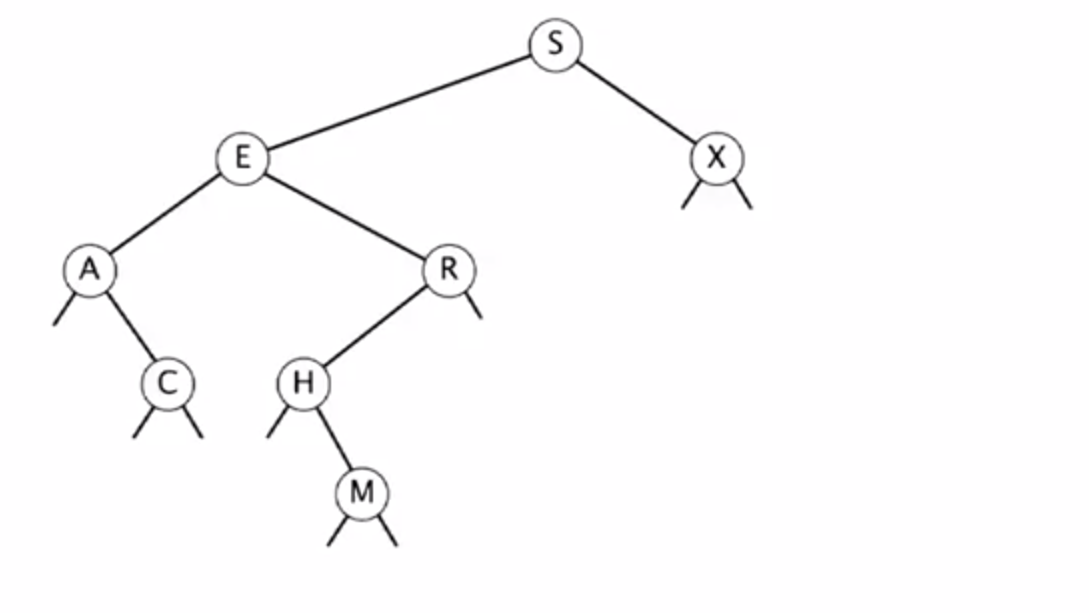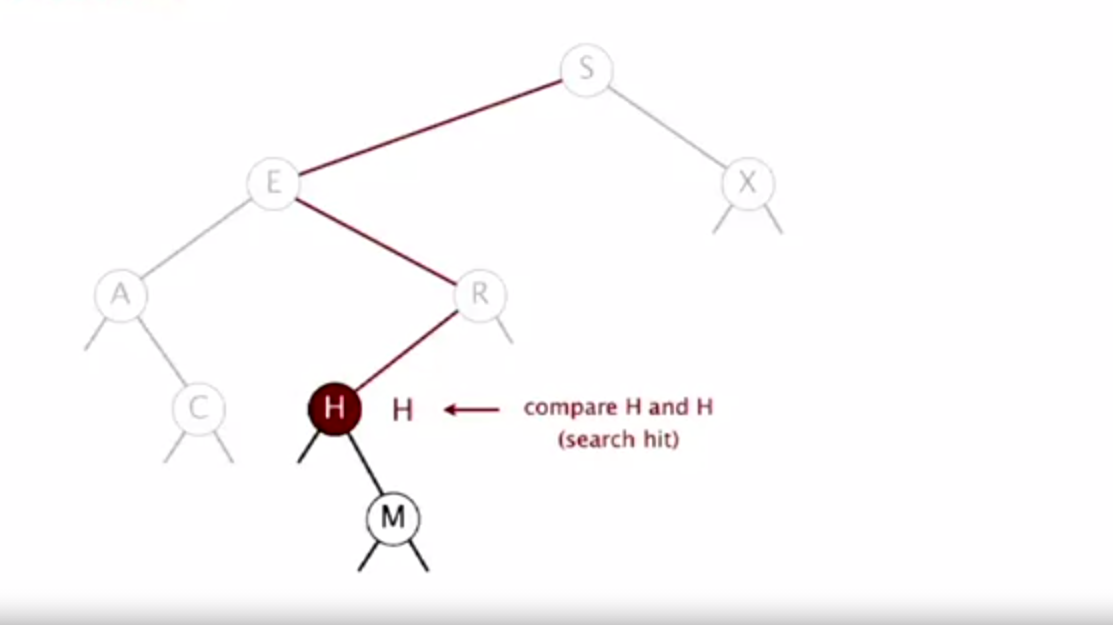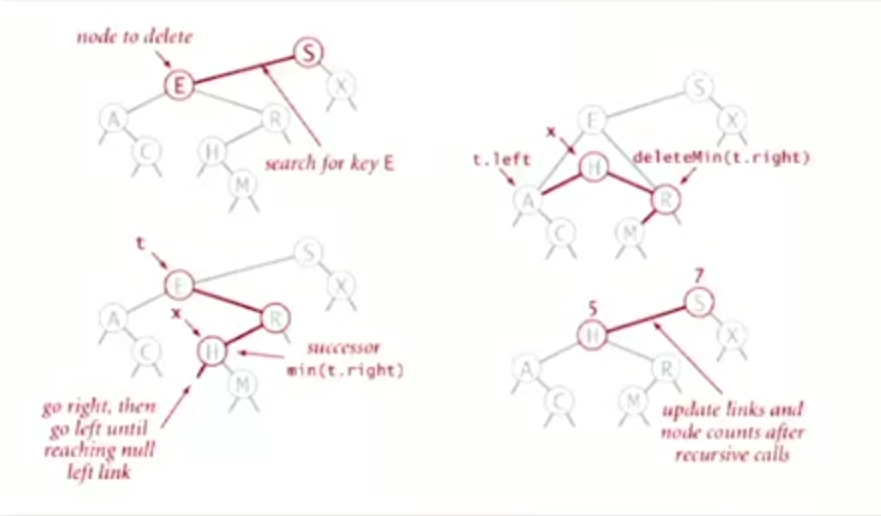Binary Search Trees
A binary search tree is a binary tree in symetric order. It has
nodes which contain information and each node has two links
to binary trees that are disjoint from one another -- a
left tree and a right tree. The links can also be null,
i.e the left tree can be null, the right tree can be null or both
can be null. In a binary search tree each node has a key and
its key is greater than all the keys in its left subtree
and smaller than all the keys in its right subtree.

Operations
A binary search tree can support many operations such as:
min(), max(), floor(), ceil() etc.. but the main ones are
get(), insert() and delete().
Insert
When inserting a node, start from the root and compare
the key's values, if the key to be inserted is less than
the root's key, go left, if it is greater go right,
repeat until a key with the same value is found in which case
replace the old value with the new value, or if no key is
found insert the new key at that position.

Search
When searching for a node, start from the root and
compare the key's values, if the key to be found is
less than the root's key, go left, if it is greater go
right, repeat until a key with the same value is found in
which return the value asssociated with that key, or if
no key is found return null;

Delete
When deleting a node, there are 3 cases to consider.
- When there is a
leftsubtree andnorightsubtree in which case theparentleft or right link needs to beupdatedto point to thenode's left subtree. - When there is a
rightsubtree andno leftsubtree in which case theparentleft or right link needs to beupdatedto point to thenode's right subtree. - When there is a
leftand arightsubtree, in which casefindtheminimumof node'srightsubtree andputit theplaceof thenodeto bedeleted, i.efindthenext biggestnodecomparedto thenodeto bedeletedandputit in itsplace. N.B that this operation is not symmetrical.

Time complexity
The time complexity of the BST greatly depends on the order
of it's input. In the worst case - inserting keys of
ascending or descending order it will be like that of a
linked list O(N). If the keys are inputed in a random
order the time complexity of the insert and search operation
is O(N) = log(N), but the time complexity of the delete
operation is sqrt(N), which can in turn make the other
operations of the BST sqrt(N) because it is not symmetric.
Implementation
Sample typescript implementation
/**
Implementable by comparable objects
*/
interface Comparable<T> {
/**
* Returns - 1 if this is greater than t,
* 0 if equal,
* 1 if this is less than this
* @param {T} t
* @returns number
*/
compareTo(t: T): number;
}
class BSTNode<Key extends Comparable<Key>, Value> {
left: BSTNode<Key, Value> | null;
right: BSTNode<Key, Value> | null;
key: Key;
value: Value;
size: number;
constructor(key: Key, value: Value) {
this.key = key;
this.value = value;
this.size = 1;
this.left = null;
this.right = null;
}
}
class BST<Key extends Comparable<Key>, Value> {
root: BSTNode<Key, Value> | null;
constructor() {
this.root = null;
}
public get(key: Key): Value | null {
let x = this.root;
while (x != null) {
const cmp = x.key.compareTo(key);
if (cmp < 0) x = x.left;
else if (cmp > 0) x = x.right;
else return x.value;
}
return null;
}
public put(key: Key, value: Value): void {
this.root = this.pvtPut(this.root, key, value);
}
public delete(key: Key): void {
if (key == null) return;
this.del(this.root, key);
}
private pvtPut(
node: BSTNode<Key, Value> | null,
key: Key,
value: Value,
): BSTNode<Key, Value> {
if (node == null) return new BSTNode(key, value);
const cmp = node.key.compareTo(key);
if (cmp < 0) {
node.left = this.pvtPut(node.left, key, value);
} else if (cmp > 0) {
node.right = this.pvtPut(node.right, key, value);
} else {
node.value = value;
}
node.size =
1 + this.sizeOf(node.left) + this.sizeOf(node.right);
return node;
}
private sizeOf(node: BSTNode<Key, Value> | null): number {
if (node == null) return 0;
return node.size;
}
private del(
node: BSTNode<Key, Value> | null,
key: Key,
): BSTNode<Key, Value> | null {
if (node == null) return null;
const cmp = node.key.compareTo(key);
if (cmp < 0) {
node.left = this.del(node.left, key);
} else if (cmp > 0) {
node.right = this.del(node.right, key);
} else {
if (node.left == null) return node.right;
if (node.right == null) return node.left;
const subMin = this.min(node.right);
node.key = subMin.key;
node.value = subMin.value;
node.right = this.delMin(node.right);
}
node.size =
1 + this.sizeOf(node.left) + this.sizeOf(node.right);
return node;
}
private delMin(
node: BSTNode<Key, Value>,
): BSTNode<Key, Value> | null {
if (node.left == null) return node.right;
node.left = this.delMin(node.left);
node.size =
1 + this.sizeOf(node.left) + this.sizeOf(node.right);
return node;
}
private min(node: BSTNode<Key, Value>): BSTNode<Key, Value> {
if (node.left == null) return node;
return this.min(node.left);
}
}Images taken from: https://www.coursera.org/learn/algorithms-part1/


